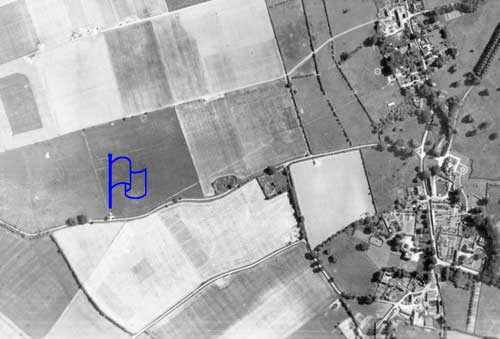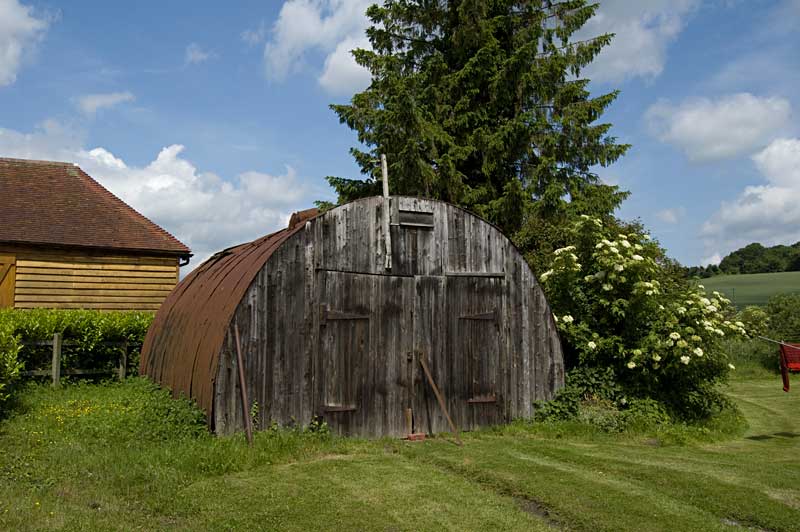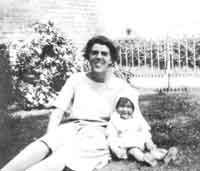

 The Scrapbook mentions “the ladies of Oak Cottage” - these were a Miss May Ollis
Pelton and Miss Vera Walker. Not only did
the ladies share their bathroom with ten men, but they were amongst
a number of W.I. ladies who did their bit for the war effort by making
jam. Up until 1941 this posed no problems as the ladies obviously made
the jam in their own homes, but in that year, the Ministry of Food issued
instructions that jam making would now have to be carried out in public
buildings. Miss Pelton wrote to the Parish Council on behalf of the
W.I., asking that the hut on the Recreation Ground be fitted with a
sink and cupboard. After much discussion the Council agreed providing
the cost did not exceed thirteen pounds. It obviously did not, as we
read in the Farnham Herald of 4th October 1941:-
The Scrapbook mentions “the ladies of Oak Cottage” - these were a Miss May Ollis
Pelton and Miss Vera Walker. Not only did
the ladies share their bathroom with ten men, but they were amongst
a number of W.I. ladies who did their bit for the war effort by making
jam. Up until 1941 this posed no problems as the ladies obviously made
the jam in their own homes, but in that year, the Ministry of Food issued
instructions that jam making would now have to be carried out in public
buildings. Miss Pelton wrote to the Parish Council on behalf of the
W.I., asking that the hut on the Recreation Ground be fitted with a
sink and cupboard. After much discussion the Council agreed providing
the cost did not exceed thirteen pounds. It obviously did not, as we
read in the Farnham Herald of 4th October 1941:-“Between 800 and 900 pounds of jam were made during the season by members of the Froyle Fruit Preservation centre at The Hut.” Oak Cottage in the summer of 1915. |
|
|
| The Home Guard Hut |

The hut, a corrugated iron Nissen Hut, was located on the road to Yarnhams, above Upper Froyle. You can still see the concrete hard standing where it stood. (In the picture the location is marked by the base of the ‘flag’).
After the war, in about 1947, it was dismantled and rebuilt in Upper Froyle as a garage.
|
 |
| Personal memories bring out the real feeling of life during those years of war. Here are a few recollections from the book “Froyle, 100 Years of Memories”. |
 Pat
Pritchard, nee Milne (picture right), who
was five years old when war broke out, remembers, “Any spaces alongside
the road were use to place old farm carts, huge concrete blocks and
rolls of barbed wire in case of invasion. The women in the village
worked
in the fields, as the men had gone to war, and some of the older boys
left school at lunchtime to harvest potatoes. The women also worked
very hard arranging functions, such as whist drives and entertainments
to raise money for a “Welcome Home Fund” and the atmosphere
in the village was wonderful. At Christmas Lady Talbot at Froyle Place
gave us an exciting party for the whole school with Father Christmas
coming down the main staircase and giving each and every one of us a
present.” Pat
Pritchard, nee Milne (picture right), who
was five years old when war broke out, remembers, “Any spaces alongside
the road were use to place old farm carts, huge concrete blocks and
rolls of barbed wire in case of invasion. The women in the village
worked
in the fields, as the men had gone to war, and some of the older boys
left school at lunchtime to harvest potatoes. The women also worked
very hard arranging functions, such as whist drives and entertainments
to raise money for a “Welcome Home Fund” and the atmosphere
in the village was wonderful. At Christmas Lady Talbot at Froyle Place
gave us an exciting party for the whole school with Father Christmas
coming down the main staircase and giving each and every one of us a
present.” Maureen Fry, nee Chappell (picture right), who was
at Froyle School from 1940 until 1946 said “We had to walk in single
file on different sides of the road on our way to school in case of
air raids. In Lower Froyle we were told to always walk on the left -
I still do!” Maureen Fry, nee Chappell (picture right), who was
at Froyle School from 1940 until 1946 said “We had to walk in single
file on different sides of the road on our way to school in case of
air raids. In Lower Froyle we were told to always walk on the left -
I still do!”
Jack Cooper, at school from 1934 until 1941, said, “Mr.Knight felt that the older children should learn our Allies’ National Anthems. I remember learning the English words to the French National Anthem and singing them in class. The school windows were all taped up and classes finished earlier in the winter to get us all home before the air raids started.”  Ann Hill (picture right),
who was born after the war started, still has vivid memories of those
years. “I remember lying in bed listening to our planes in the
dark”, she said. “Of course, we had to be very careful with
the blackout up at the windows at night. I remember the signs were taken
down on the roads. My father made an air raid shelter in the garden
and we all went into it when we thought the bombs might come. We had
oil lamps down there, as well as a wood burning stove to help keep us
warm. There were bunk beds, I remember, but no running water. You had
to take food and water with you if you had time, as you had no idea
how long you might have to stay down there.” Ann Hill (picture right),
who was born after the war started, still has vivid memories of those
years. “I remember lying in bed listening to our planes in the
dark”, she said. “Of course, we had to be very careful with
the blackout up at the windows at night. I remember the signs were taken
down on the roads. My father made an air raid shelter in the garden
and we all went into it when we thought the bombs might come. We had
oil lamps down there, as well as a wood burning stove to help keep us
warm. There were bunk beds, I remember, but no running water. You had
to take food and water with you if you had time, as you had no idea
how long you might have to stay down there.”As we saw earlier, Ann’s father was the Air Raid Warden for Froyle. Her mother was also busy during the war, nursing and working with the Red Cross in the area. She received a medal for her service at the end of the War. Pam Vivian’s family also had an air raid shelter in the garden of the Butcher’s Shop. “Ours often had a foot of water in it” she said, “and we only slept there a few times in the early days when the planes came over Aldershot and Odiham.”  David
Bennett (picture right)
was one of those children who came to Froyle from London. David
Bennett (picture right)
was one of those children who came to Froyle from London.“It was during the war-years that I first visited Froyle and spent a few months here. During this time I had to attend Froyle School. It seemed so safe in the country. It was good to sleep without fear of German bombers and Doodle-bugs and no interruption at school - well, I didn’t really mind that! The highlight of going to and from Froyle School was to watch the Village Blacksmith at work. In Church Street, Alton, the Evangelical Free Church was then called the Foresters Hall. All types of events were staged there. One such event was a party for London kids only. I had a great time - the bonus of extra food a treat on its own.”  Francis
Milne (picture right) remembers standing in the hop fields and watching the Battle of Britain! “The Home Guard was formed and I was a messenger between Home Guard,
A.R.P. and firefighters. Grandad and I caught rabbits, grandad prepared
them for the pot and we sold them at 2/6d each, they were a main source
of food during the war years.” Francis
Milne (picture right) remembers standing in the hop fields and watching the Battle of Britain! “The Home Guard was formed and I was a messenger between Home Guard,
A.R.P. and firefighters. Grandad and I caught rabbits, grandad prepared
them for the pot and we sold them at 2/6d each, they were a main source
of food during the war years.”
|
| Finally, one quote from the book which says everything about the people of Froyle who lived through those years! |
 Joyce
Kemp told me a lovely anecdote, which, I believe, sums up a lot
of people’s attitude during war time. She remembers, “how
everyone worked hard to help keep Britain fed. They often worked on
even when the sirens had sounded. They were used to carrying on in bad
weather so they were not going to stop for a few bombs! Joyce
Kemp told me a lovely anecdote, which, I believe, sums up a lot
of people’s attitude during war time. She remembers, “how
everyone worked hard to help keep Britain fed. They often worked on
even when the sirens had sounded. They were used to carrying on in bad
weather so they were not going to stop for a few bombs!One day, during the war, Auntie Ena called in to see us in Alton after her usual trip to market. We were chatting with friends about the bombs which had dropped nearby in the night. “Well, I can’t stand here talking” Aunty said “I’ve got a load of logs to move”, and off she went, A friend of ours remarked “Hitler doesn’t stand a chance - not while there are people about like your Aunt!”” Picture right: Ena Westbrook in 1930 with her niece, Ruth Smither. |